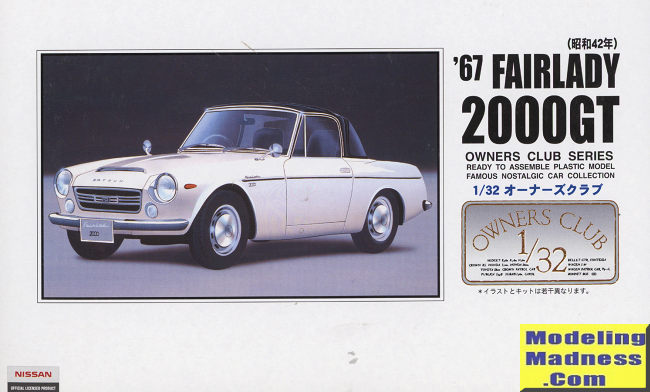
Arii 1/32 1967 Fairlady 2000GT
| KIT #: | 41009 |
| PRICE: | 800 yen SRP |
| DECALS: | Racing stickers |
| REVIEWER: | Scott Van Aken |
| NOTES: | Curbside |

| HISTORY |
The Datsun Sports (called Datsun Fairlady in the Japanese and Australian markets), was a series of roadsters produced by Nissan in the 1960s. The series was a predecessor to the Z-car in the Fairlady line, and offered a competitor to the European MG, Triumph, Fiat and Alfa Romeo sports cars. The line began with the 1959 S211 and continued through 1970 with the SP311 and SR311 lines.
The Fairlady saw competitors follow its introduction, with examples called the Honda S500, the Toyota Sports 800, and the Daihatsu Compagno. In Japan, it represented one of three core products offered by Nissan at Japanese Nissan dealerships called Nissan Shop, alongside the Datsun Truck and the Datsun 1000. The Datsun SRL 2000 was the two-seat roadster that made their name. Paul Newman started his racing career in one. It had a potent 1,982cc overhead cam engine with dual SU type side draft carbs and a five-speed transmission. In 1991, Nissan introduced a limited number two-door convertible styled in a retro appearance to the Datsun Sports called the Nissan Figaro.
| THE KIT |
 This
is the two door coupe version and like all of the Arii kits in this series, is a
curbside (which means the kit does not have an engine). Typical of the series,
there are no chrome parts, those requiring the modeler to paint. Fortunately for
the modern builder, there are several excellent chrome paints on the market.
This
is the two door coupe version and like all of the Arii kits in this series, is a
curbside (which means the kit does not have an engine). Typical of the series,
there are no chrome parts, those requiring the modeler to paint. Fortunately for
the modern builder, there are several excellent chrome paints on the market.
Construction is quite simple and you will spend most of your time painting. The interior is a full floor pan with wheel wells into which you attach the seats and interior door panels. Unlike many of its sedan kits, this one actually has a suspension and drive shaft to place under the floor pan. As such, there are no axles included, merely stubs on which to attach the wheels. Wheels are separate from the rubber tires. Also unlike most of their other car kits, there are no decals for the instrument panel, plates or logos.
The instrument panel with steering wheel installs in the body and this must be installed after the one piece window part. The front and rear of the body are separate parts and it would be recommended to paint the body after gluing on the front and rear panel, but before installing anything else. Headlight lenses are separate clear items as are the tail lights and turn signals. I have had success painting the area behind these last two items with white or chrome and using orange and red Sharpies for color. Once all the bits are attached to the body, it can be glued to the chassis. The kit comes with a convertible top, but like most roadsters, it does not add to its looks at all. Unfortunately, there is no top down cover, so you are pretty well stuck with doing it top up.
Instructions are a single folded sheet with pretty much everything in Japanese. Fortunately, the construction drawings are well done and should not be an issue. You are fairly well on your own in terms of color, however, there are plenty of images on the 'net to help. The small decal sheet is well done and has proven to work quite well on previous kits.
| CONCLUSIONS |
These kits are a nice distraction from the usual for those of use who don't usually do cars. For those who do, they can provide a break from the normal scale. I was not surprised to see a bit of flash on the clear bits. Considering how long these kits have been produced, the molds are in surprisingly good condition.
| REFERENCES |
https://en.wikipedia.org/wiki/Datsun_Sports
August 2018 Copyright ModelingMadness.com.
All rights reserved. Thanks to me for ordering it. If you would like your product reviewed fairly and fairly quickly, please contact the editor or see other details in the
Note to
Contributors. Back to the Main Page
Back to the Review
Index Page
Back to the Previews Index Page